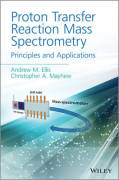|
||
podział tematyczny • wydawnictwa anglojęzyczne podział tematyczny Newsletter: • Zamów informacje o nowościach z wybranego tematu Informacje: • sposoby płatności i dostawy • kontakt • Cookies na stronie • Regulamin zakupów Napisz propresssp@gmail.com |
PROTON TRANSFER REACTION MASS SPECTROMETRYELLIS A.M. MAYHEW CH. A.wydawnictwo: BLACKWELL SCIENCE , rok wydania 2014, wydanie Icena netto: Proton Transfer Reaction Mass Spectrometry (PTR-MS) is a rapidly growing analytical technique for detecting and identifying very small quantities of chemical compounds in air. It has seen widespread use in atmospheric monitoring and food science and shows increasing promise in applications such as industrial process monitoring, medical science and in crime and security scenarios. Written by leading researchers, this is the first book devoted to PTR-MS and it provides a comprehensive account of the basic principles, the experimental technique and various applications, thus making this book essential reading for researchers, technicians, postgraduate students and professionals in industry. The book contains nine chapters and is divided into two parts. The first part describes the underlying principles of the PTR-MS technique, including * the relevant ion-molecule chemistry * thermodynamics and reaction kinetics * a discussion of ion sources, drift tubes and mass spectrometers * practical aspects of PTR-MS, including calibration. The second part of the book turns its attention to some of the many applications of PTR-MS, demonstrating the scope and benefits, as well as the limitations, of the technique. The chapters that make up the second part of the book build upon the material presented in the first part and are essentially self-contained reviews focusing on the following topics: * environmental science * food science * medicine * homeland security, and * applications of PTR-MS in liquid analysis. Quotation xiii Preface xv SECTION 1 FUNDAMENTALS 1 Background 3 1.1 Volatile Organic Compounds in the Earth's Atmosphere 3 1.2 Volatile Organic Compounds in Other Environments 5 1.3 Techniques for VOC Measurements 6 1.4 Emergence of Proton Transfer Reaction Mass Spectrometry 15 References 23 2 Chemical Ionization: Chemistry, Thermodynamics and Kinetics 25 2.1 Introduction 25 2.2 Proton Transfer 27 2.3 Other Chemical Ionization Processes 44 References 45 3 Experimental: Components and Principles 49 3.1 Introduction 49 3.2 Ion Extraction and Ion Optics 50 3.3 Ion Sources 57 3.4 Drift Tubes 64 3.5 Mass Spectrometry 76 3.6 Ion Detectors 97 3.7 Analogue versus Digital Signal Processing 103 References 106 4 Quantitative Analysis 111 4.1 Introduction 111 4.2 Extracting the Concentration of a Trace Gas from PTR-MS 111 4.3 Normalized Counts per Second 112 4.4 Why Calibrate? 113 4.5 Calibration Techniques 116 4.6 Effect of Humidity 120 4.7 Accuracy, Precision and Limit of Detection 122 4.8 Validation of PTR-MS 125 References 126 SECTION 2 APPLICATIONS 5 PTR-MS in the Environmental Sciences 131 5.1 Background 131 5.2 Use of Reagent Ions Other Than H3O+ 138 5.3 Biogenic VOCs 141 5.4 Anthropogenic VOCs 156 5.5 Biomass Burning 166 5.6 Applications of PTR-MS to Laboratory Studies of Atmospheric Chemistry 169 5.7 Plant Studies 178 5.8 Outlook for Atmospheric and Environmental Applications of PTR-MS 201 References 201 6 PTR-MS in the Food Sciences 219 6.1 Background 219 6.2 Combined GC--MS and PTR-MS Studies for Food Analysis 221 6.3 Mass Spectral Fingerprinting 224 6.4 Flavour Release and Perception 225 6.5 Food Classification, Food Quality and Food Control 243 6.6 Outlook for Food Science and Technology Applications 254 References 255 7 PTR-MS in the Medical Sciences 265 7.1 Background 265 7.2 Breath Analysis 266 7.3 Online PTR-MS Measurements of Volatile Emissions from Microbial Cultures 288 7.4 Other Medical Applications 295 References 300 8 Applications of PTR-MS to Homeland Security: The Detection of Threat Agents 309 8.1 Background 309 8.2 Explosives 310 8.3 Chemical Warfare Agents and Toxic Industrial Chemicals 319 8.4 Narcotics 320 8.5 Date Rape Drugs 323 8.6 Ion Mobility Mass Spectrometry and PTR-MS: A Brief Comparison for Homeland Security Applications 324 8.7 Future Directions 325 References 326 9 Liquid Analysis Using PTR-MS 329 9.1 Determination of Henry's Law Constants Using PTR-MS 329 9.2 Analysis of Liquids 331 References 334 Index 366 pages, Hardcover Księgarnia nie działa. Nie odpowiadamy na pytania i nie realizujemy zamówien. Do odwolania !. |


